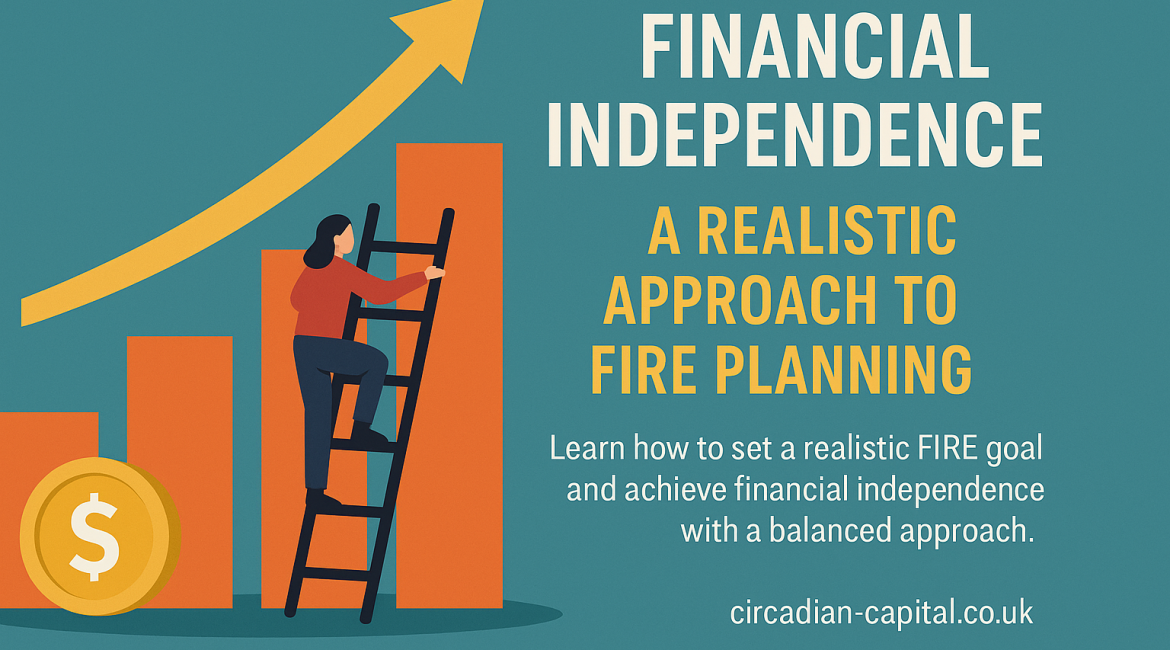The FIRE (Financial Independence, Retire Early) movement has gained significant popularity in recent years. More people in the UK are seeking the freedom to retire early, live on their terms and escape the traditional work grind. But achieving FIRE isn’t just about saving as much money as possible, it’s about setting a goal that works for you and your lifestyle.
FIRE isn’t just about how much money you are saving. It’s about having the right mindset and making sure your goals are realistic.
At Circadian Capital, we understand that FIRE isn’t just about hitting some financial target but about finding the balance that works for you. It’s about having the right mindset and making sure your goals are realistic. So, let’s dive into the steps to set a Fire goal and achieve financial independence.
1. The Psychological Drivers Behind FIRE
First, let’s dive into why people want FIRE? For most people, it’s all about freedom. It’s a desire to break free from the daily grind and spend their time on what truly matters to them. In fact, about 68% of people pursuing FIRE consider retirement to be a “prosperous” time.
But here’s where things get challenging, FIRE means a lot of sacrifices. To achieve your goals, you will have to curb your expenses and stop spending on little luxuries like dining out, spontaneous trips or buying the latest gadgets. And it can be stressful and isolating for some. It’s easy to feel like you’re missing out. The key to managing it is to stay focused on your goals and long term rewards.
2. How to Set a Realistic FIRE Goal
Achieving FIRE goals can be stressful and requires a lot of sacrifice, even more so if the goals are not set in reality. Setting a realistic FIRE goal requires careful planning, both financially and mentally.
Step 1: Assess Your Current Financial Situation
Before you start planning your FIRE goal, you need to know where you stand financially. Look at your income, your expenses, any debts and how much you’re saving. A lot of people jump into FIRE without a plan.
Studies show that about 30% of people have no idea how much money they’ll actually need to retire comfortably. Start with creating a plan, assess your financial situation, future expenses and write down your retirement goals.
Step 2: What Does Your Dream Life Look Like?
What do you want your life to look like once you’re financially independent? Do you want to travel the world? Launch your own business? or spend more time with friends & family? The clearer your vision, the more accurate your FIRE target will be.
Whatever your vision is, be specific. If you’re living in London, for example, you’re looking at an average cost of £1,000-£1,500 per month just for living expenses – rent not included. So, think about that when setting your FIRE goal. Will your financial investments cover those expenses? Consider making a financial plan for these expenses and hobbies.
Step 3: Passive Income is Key
One of the main components of FIRE is generating passive income. This is income that comes from investments or other sources that don’t require active work. The more passive income you can create, the faster you can achieve FIRE.
Building passive income takes time. But the earlier you start, the sooner you’ll see results. If you focus on growing your investments, it will pay off in the long run.
Step 4: Break Your Goal Down into Milestones
Rather than focusing on one big goal, break it down into smaller, achievable targets. Instead of focusing on one massive target (like “retire by 40”), break it down into smaller, more manageable steps. Aim to save 20-25% of your income this year, and then bump it up to 40% next year. Make it a challenge, but keep it realistic.
3. Avoiding Burnout and Overcoming Psychological Barriers to FIRE
When you’re focused on FIRE, it’s easy to feel like you’re missing out. While everyone’s going on trips, splurging on fancy dinners and buying new tech; you are cutting back and saving up. It can be tough. But FIRE is about prioritising your future. The sacrifices you make now will give you the freedom to live life on your own terms later.
Pushing yourself too hard can lead to burnout. Yes, saving and investing aggressively is important, but you also need to live in the present. Financial independence doesn’t need to come at the cost of your mental health. You can still save for FIRE while taking care of yourself. Set aside some funds for short-term rewards, like a weekend getaway or a nice dinner out. This will help keep you motivated on your journey to FIRE.
4. Tracking Progress and Adjusting the Plan
The road to FIRE won’t always be smooth. Unexpected expenses, market fluctuations, and other setbacks are part of the journey. But these setbacks don’t mean failure. It’s about adjusting your strategy when things go off course.
You’re not going to hit your financial goals tomorrow, but tracking your progress is key. Regular check-ins will help you see how far you’ve come and adjust if you need to. Most people who pursue FIRE check in on their plan at least once a year. And don’t forget to celebrate the small victories along the way.
Conclusion: Achieving Financial Independence with the Right Mindset
Financial independence and early retirement are possible, but they require the right approach. Setting a realistic FIRE goal means understanding your finances, defining your desired lifestyle, and maintaining a sustainable strategy. The key is to stay focused and adjust your plan as life changes.
At Circadian Capital, we’re all about helping you make FIRE a reality, not by pushing unrealistic goals but by helping you build a financial plan that works for your life. Ready to start your FIRE journey? Reach out today, and we’ll figure out a plan that works for you.

